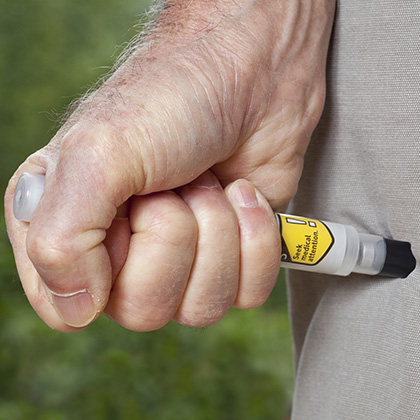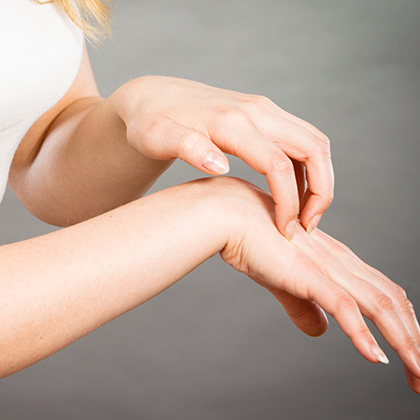Insect bites and stings are common and, in most cases, not dangerous. If you get bitten, it means an insect has made a hole in your skin through which it can feed. Your skin will usually react by becoming red, swollen and itchy, which is a reaction to the saliva the insect releases when it bites you. A sting can also make a red, swollen and itchy mark on your skin, which is the result of the insect injecting venom into your skin. In both cases, the affected area can be painful and itchy, but the discomfort should only last a few days.
However, a very small number of people can have a severe allergic reaction to an insect bite or sting called anaphylaxis, which can be life threatening. According to the American College of Allergy, Asthma & Immunology, potentially life-threatening allergic reactions affect 0.4 - 0.8 per cent of children and three per cent of adults, with up to 100 deaths per year in the US resulting from insect sting anaphylaxis (i).
The symptoms of a severe allergic reaction after a bite or sting include breathing difficulties, wheezing, dizziness, lightheadedness, difficulty swallowing, nausea, vomiting, diarrhoea and a fast heart rate. To discover how to manage allergies in extreme cases, see our guide to anaphylaxis.
If you experience any of these symptoms after being bitten or stung, call 999 for emergency help immediately.
Home-grown biters and stingers
There are several types of insects found in the UK that bite and sting.
Biters include the following:
Midges and gnats
Common throughout the UK, midges and gnats can give you a nasty bite, making your skin painful, itchy and often very red and swollen. These insects don’t transmit disease, however.
Mosquitos
The type of mosquitos found in the UK don’t carry deadly diseases as they do in some parts of the world (see Mosquito advice for travellers, below). But if you’re bitten, your skin can become swollen and very itchy.
Fleas
Fleas don’t just affect your pets, they can bite humans too. Even if you don’t have a pet, you can be bitten by a flea in your back garden. Their bites cause small red itchy bumps, often in groups of three or four or in a straight line.
Bedbugs
Contrary to what you might think, bedbugs aren’t a sign of poor domestic hygiene because they aren’t attracted to dirt (in fact they are attracted to heat and carbon dioxide). Their bites can cause itchy red bumps – usually around the face, neck, hands or arms – that last for several days. Some people can react more severely to bedbug bites than others.
Ticks
Ticks are small spider-like creatures that aren’t actually insects. But they can transmit Lyme disease here in the UK, which can cause serious health problems (see What is Lyme disease? below).
Spiders
Also not insects, spiders are thought to be harmless in this country, but there are some types that can bite if they get trapped in your clothes or if they’re disturbed or feel threatened. The main type of biting spider in the UK is thought to be the false widow spider, whose bites can cause swelling, redness and pain.
Other biting insects include horse flies, flower bugs and ladybirds (especially harlequin ladybirds).
Meanwhile, the following insects sting:
Bees
Both types of bees found in the UK can sting. Honey bees leaves a barbed sting in your skin, which you should remove to prevent an infection (carefully flick or scrape out the sting with your fingernail or a credit card while trying not to puncture the venom sac). Bumble bees are less aggressive than honey bees, and they’re unlikely to sting you unless they feel threatened. But unlike honey bees they can sting you several times (they also don’t have barbed stings). Both types of bee stings can be painful, and can cause a serious allergic reaction in some people.
Wasps
Both wasps and hornets can sting if threatened. The result can be itching and swelling, as well as allergic reactions (according to the Anaphylaxis Campaign, along with honey bee stings, wasp stings cause the most allergic reactions from insects in the UK (ii)). Even if you’ve had one or more wasp sting before, you could develop an anaphylactic reaction to your next one.
Ants
Flying ants as well as red and wood ants can sting, but the black ants you find in your garden don’t. Ant stings aren’t harmful and are usually much less painful than bee or wasp stings.
Preventing bites and stings
While it’s not always possible to avoid being bitten or stung by an insect, there are things you can do to make a bite or sting less likely – which is especially important if you’ve had a bad reaction to a bite or sting previously:
Cover up
Many insects are usually more active at the start or end of the day, so cover yourself up with long sleeves and trousers or a long skirt if you’re out and about at sunrise or sunset. Also wear shoes that protect your feet, and avoid wearing bright colours that may attract stinging insects (go for white or neutral colours).
Protect exposed areas
Apply insect repellent sparingly to any parts of your skin that aren’t covered up. Most experts recommend products that contain an ingredient called diethyltoluamide (DEET), are generally considered the most effective (iii). However, DEET-based insect repellents may not be appropriate for everyone, particularly the very young, so check the label before you use them (DEET products shouldn’t be used on babies younger than two months). Some insect repellents are designed for sensitive or children’s skin, or you may want to try a natural insect repellent or one with a low dose of chemicals if you’re pregnant or breastfeeding.
Go fragrance free
Bees and other insects are also attracted by smells, so avoid wearing any perfumes, including hairspray or scented hand or body lotion.
Hide sweet treats
Keep food – especially fruit and other sweet foods – and drinks covered up, as these too can attract bees and other insects. And if you have a choice, go for a picnic on the beach rather than in the countryside, as there tend to be fewer insects at the seaside.
Don’t panic
Bees, wasps and hornets can feel threatened if you wave your arms around when there’s one near you or if you try to swat at them. Instead, try to keep calm and move away from them slowly, without making any sudden movements. Also don’t try to remove or disturb a wasps’ nest if you find one – the best thing to do is report it to your local authority, which can arrange to have it removed safely.
Stay away
Finally, try to avoid areas where there may be lots of biting or stinging insects, such as ponds and other sources of outdoor water, flowering plants and rubbish and compost bins.
If you do get bitten or stung, wash the affected area with mild soap and water and try not to scratch. Use an insect bite/sting cream as it can help to reduce the pain, swelling and itching. Several creams that contain an antihistamine or local anaesthetic are available over the counter, or you could use a mild steroid cream to soothe itching instead.
Other things you can do include using an ice pack to reduce swelling (never put ice directly on your skin, always wrap it in a towel or similar first) – a cold compress will have the same effect (soak a flannel or cloth with cool water, wring and apply). If the bite or sting is painful, taking an over-the-counter painkiller such as paracetamol or ibuprofen may also be useful. You may also want to consider taking an antihistamine tablet to counteract swelling and itching (these too are available over the counter).
Meanwhile, if the swelling is severe or you have even a mild allergic reaction after being bitten or stung, see your GP (after having a mild allergic reaction you may suffer a more serious reaction if you’re bitten or stung again). If you experience a severe allergic reaction to a bite or sting, call 999 for emergency medical help.
Mosquito advice for travellers
If you’re bitten by a mosquito in the UK, it can be a nuisance – but it’s usually harmless. In many other places in the world, however, mosquitos can spread diseases such as malaria and the Zika virus.
Malaria is found in many tropical and subtropical countries, including many areas of Africa and Asia, Central and South America, Haiti and the Dominican Republic, parts of the Middle East as well as some Pacific islands. Malaria symptoms often start between seven and 18 days after you’ve been infected. It can give you a fever, headache, diarrhoea and muscle pains, and you may vomit and have cold sweats – all from a single mosquito bite. If untreated, it can cause serious problems and can even be fatal.
Meanwhile, many countries in South and Central America as well as the Caribbean and some parts of North America have active transmission of the Zika virus. While it may cause mild to no symptoms, Zika has been linked to birth defects such as microcephaly (an abnormally small head, which has been linked with brain development problems). Ahead of booking your holiday, take a look at some of the travel ailments and considerations you should be aware of before taking off.
How to protect yourself
If you’re travelling outside the UK, the following steps will help to keep you safe from disease-carrying mosquitos:
-
Find out if there’s malaria or Zika in the country you're travelling to – and do it well in advance, at least six to eight weeks before you travel (though even last-minute advice could help protect you against the disease). Check your destination at Fit For Travel.
-
Use an insect repellent that contains DEET. Follow the instructions on the packaging and don't forget to reapply frequently (apply sunscreen before insect repellent when using at the same time). Also use a mosquito net that has been treated with DEET-containing insecticide to keep you safe while you sleep.
-
Wear long trousers or a long skirt and sleeves after sunset, and treat your clothes with insect repellents too.
-
Take anti-malaria tablets – your GP will tell you which type you need. Follow the advice you’re given carefully on how to take them. Always finish the course of tablets.
-
If you do become unwell for up to a year after you return home – especially if you have a high temperature or flu-like symptoms – don't delay, see your doctor.
-
Finally, if you’re pregnant and have previously been travelling to an area with active Zika virus transmission, make sure your GP or your midwife knows about it.
What is Lyme disease?
Certain types of ticks carry bacteria that can spread an infection called Lyme disease. The ticks that cause it are tiny – about the size of a poppy seed – and are carried by deer, small mammals and birds.
Many people think it’s a problem that only affects other countries. But Lyme disease ticks are here in the UK too, with hotspots including Exmoor, the New Forest, the South Downs, Thetford Forest, the Lake District, the North York Moors, the Scottish Highlands and parts of Wiltshire, Berkshire, Surrey and West Sussex (according to the charity Lyme Disease Action, not all ticks in the UK are infected with Lyme disease – the infection rate varies from one place to another from zero to 15 per cent (iv)). But you don’t have to go to the country to get bitten, as they’re also in city parks and our back gardens. Tick season lasts from late spring through to autumn. The ticks are found in long grass, bracken and areas of overgrown vegetation, and they hook onto your clothing or skin before they bite. You may not even realise you’ve been bitten, as not only are the ticks very small, their bites don’t sting or itch either.
Lyme disease symptoms
The first thing you may notice is a circular red rash called erythema migrans that spreads slowly (though not everyone bitten by a Lyme disease-carrying tick gets the rash). Other early signs include flu-like symptoms such as headaches, severe fatigue, muscle and joint pain, plus a stiff neck, disturbed sleep, blurred vision and swollen glands.
If it isn’t treated, Lyme disease can affect your heart and your nervous system, with a very small number of people going on to develop bacterial meningitis or myocarditis (inflammation of the heart muscles).
But if it’s caught early enough, Lyme disease can be treated effectively with antibiotics. It is, however, difficult to diagnose, as it shares symptoms with several other common conditions. Blood tests used to confirm a diagnosis can also be unreliable, especially during the early stages of the infection when they can produce a negative result. Similarly, sometimes the result can be positive when you don’t have the infection.
How to prevent it
Prevention is undoubtedly the best option when it comes to Lyme disease. Here’s how to reduce your risk of getting bitten:
-
Whenever you’re out and about in a potential tick area, wear long sleeves and trousers.
-
Keep to pathways if you can, and avoid overgrown areas (including long grass).
-
Use an insect repellent that’s effective against ticks.
-
Check your skin and clothing for ticks regularly while you’re out, and again when you get home (check your dogs for ticks too).
-
If you find a tick, remove it immediately using a tick removal tool (available from Lyme Disease Action). Don’t burn it off or squash it with your fingers, as this increases the chance of infection.
If you have – or suspect you have – been bitten, look out for the early symptoms within the following few weeks. For more information, visit lymediseaseaction.org.uk.
Natural remedies for insect bites and stings
Using an insect repellent that contains the chemical DEET is arguably the most effective treatment you can use to reduce your risk of getting bitten by mosquitos and other insects such as fleas and ticks. However many people are wary of using such chemicals on their skin.
That said, DEET has been shown to be safe when used correctly, and after many years of use it’s only been linked with a small number of adverse reactions (v). Meanwhile, some claim taking vitamin B1 (thiamin) may act as a natural insect repellent, but there’s no real evidence to support this idea.
Quercetin
A flavonoid available in supplement form, quercetin may be more useful as a treatment for bites and stings. Quercetin is thought to act as a natural antihistamine (vi), while its anti-inflammatory properties may help relieve swelling. Food sources include red wine, grapefruit, onions, apples, black tea, leafy green vegetables and beans.
Lavender Oil
Meanwhile, lavender oil has a traditional use as a treatment for insect bites and stings. Apply diluted lavender oil directly to areas of affected skin (blend up to 12 drops in 30ml grapeseed oil or another carrier oil).
References:
-
Available online: https://acaai.org/allergies/types/insect-sting-allergy
-
Available online: https://www.anaphylaxis.org.uk/wp-content/uploads/2015/07/Insect-stings-v10-formatted.pdf
-
Available online: https://www.nhs.uk/conditions/insect-bites-and-stings/
-
Available online: https://www.lymediseaseaction.org.uk/about-ticks/
-
Qiu. H, Jun. HW, McCall. JW, et al. Pharmacokinetics, formulation, and safety of insect repellent N,N-diethyl-3-methylbenzamide (deet): a review. . J Am Mosq Control Assoc. 1998;14:12–27.
-
Ogasawara. H, Middleton. E Jr. Effect of selected flavonoids on histamine release (HR) and hydrogen peroxide (H2O2) generation by human leukocytes [abstract]. J Allergy Clin Immunol. 1985;75(suppl):184
Middleton. E Jr. Effect of flavonoids on basophil histamine release and other secretory systems. Prog Clin Biol Res. 1986;213:493-506.
Related Posts
Disclaimer: The information presented by Nature's Best is for informational purposes only. It is based on scientific studies (human, animal, or in vitro), clinical experience, or traditional usage as cited in each article. The results reported may not necessarily occur in all individuals. Self-treatment is not recommended for life-threatening conditions that require medical treatment under a doctor's care. For many of the conditions discussed, treatment with prescription or over the counter medication is also available. Consult your doctor, practitioner, and/or pharmacist for any health problem and before using any supplements or before making any changes in prescribed medications.

Christine
Christine Morgan has been a freelance health and wellbeing journalist for almost 20 years, having written for numerous publications including the Daily Mirror, S Magazine, Top Sante, Healthy, Woman & Home, Zest, Allergy, Healthy Times and Pregnancy & Birth; she has also edited several titles such as Women’ Health, Shine’s Real Health & Beauty and All About Health.
View More



